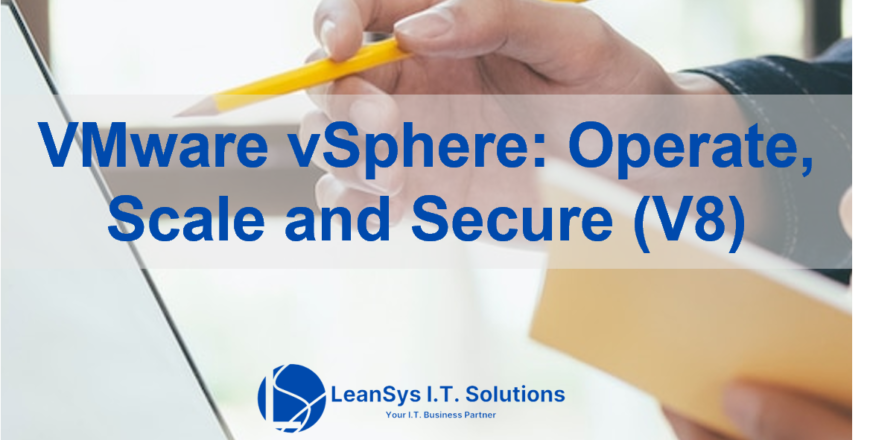
- Description
- Reviews
COURSE BRIEF
Course Name: VMware vSphere: Operate, Scale and Secure (V8)
Duration: 5 Days
Delivery Method: Classroom / Virtual Instructor-Led training
Course Overview
This five-day course teaches you advanced skills for configuring and maintaining a highly available and scalable virtual infrastructure. Through a mix of lecture and hands-on labs, you configure and optimize the VMware vSphere 8 features that build a foundation for a truly scalable infrastructure. You also discuss when and where these features have the greatest effect. Attend this course to deepen your understanding of vSphere and learn how its advanced features and controls can benefit your organization.
Course Objectives
By the end of the course, you should be able to meet the following objectives:
· Configure and manage a VMware Tools Repository
· Configure vSphere Replication and recover replicated VMs
· Manage VM resource usage with resource pools
· Configure and manage vSphere networking and storage for a large and sophisticated enterprise
· Configure VMware vCenter Server® High Availability
· Use host profiles to manage VMware ESXi™ 8 host compliance
· Use the vSphere Client and the command line to manage certificates
· Monitor the vCenter, ESXi, and VMs performance in the vSphere client
· Secure VMware vCenter® 8, ESXi, and VMs in your vSphere environment
· Use Identity Federation to configure the vCenter to use external identity sources
· Use VMware vSphere® Trust Authority™ secure the infrastructure for encrypted VMs
Taret Audience
Experienced system administrators, system engineers, and system integrators
Course Outline
1 Course Introduction
· Introductions and course logistics
· Course objectives
2 Virtual Machine Operations
· Recognize the role of a VMware Tools™ Repository
· Configure a VMware Tools Repository
· Recognize the backup and restore solution for VMs
· Identify the components in the VMware vSphere® Replication™ architecture
· Deploy and configure vSphere Replication and VMware Site Recovery™ instances
· Recover replicated VMs
3 vSphere Cluster Operations
· Create and manage resource pools in a cluster
· Describe how scalable shares work
· Describe the function of the vCLS
· Recognize operations that might disrupt the healthy functioning of vCLS VMs
4 Network Operations
· Configure and manage vSphere distributed switches
· Describe how VMware vSphere® Network I/O Control enhances performance
· Explain distributed switch features such as port mirroring and NetFlow
· Define vSphere Distributed Services Engine
· Describe the use cases and benefits of VMware vSphere® Distributed Services Engine™
5 Storage Operations
· Discuss vSphere support for NVMe and iSER technologies
· Describe the architecture and requirements of vSAN configuration
· Describe storage policy-based management
· Recognize components in the VMware vSphere® Virtual Volumes™ architecture
· Configure Storage I/O Control
6 vCenter and ESXi Operations
· Create a vCenter backup schedule
· Recognize the importance of vCenter High Availability
· Explain how vCenter Server High Availability works
· Use host profiles to manage ESXi configuration compliance
· Recognize the benefits of using configuration profiles
· Use the vSphere client and the command line to manage certificates
7 vSphere Monitoring
· Monitor the key factors that can affect a virtual machine’s performance
· Describe the factors that influence vCenter performance
· Use vCenter tools to monitor resource use
· Create custom alarms in vCenter
· Describe the benefits and capabilities of VMware Skyline™
· Recognize uses for VMware Skyline Advisor™ Pro
8 vSphere Security and Access Control
· Recognize strategies for securing vSphere components, such as vCenter, ESXi hosts, and virtual machines
· Describe vSphere support for security standards and protocols
· Describe identity federation and recognize its use cases
· Configure identity federation to allow vCenter to use an external identity provider
9 vSphere Trusted Environments and VM Encryption
· Configure ESXi Host Access and Authentication
· Describe virtual machine security features
· Describe the components of a VM encryption architecture
· Create, manage, and migrate encrypted VMs
· List VM encryption events and alarms
· Describe the benefits and use cases of vSphere Trust Authority
Prerequisites
This course requires the following:
· Attend VMware vSphere: Install, Configure, Manage (V8)
· Equivalent knowledge and administration experience with ESXi and vCenter
· Experience with working at the command line is highly recommended.
